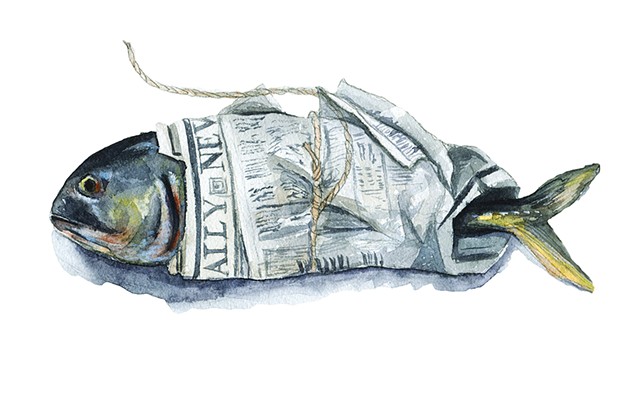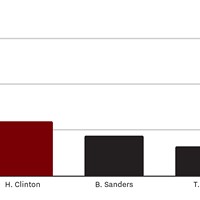We are Never Only Talking About Food
A critical eye on food media
By Jennifer Fumiko Cahill [email protected] @jfumikocahill[
{
"name": "Top Stories Video Pair",
"insertPoint": "7",
"component": "17087298",
"parentWrapperClass": "fdn-ads-inline-content-block",
"requiredCountToDisplay": "1"
}
]
I am always talking about food. Ask anybody. Better yet, try to have a conversation about anything else with me and keep an eye on your stopwatch to see how fast I can steer us back. Why? Well, that's likely a longer column. But the how is easy: Food touches everything.
Food is life or death, art and pleasure. Some of our earliest memories and final desires are about food. A dish can tell the story of a singular palate, a family tradition, a people's history. Our diets and food budgets are often the objects of moral judgements. Who grows, cooks, sells, consumes and profits from food — and how — is deeply political. How food is harvested and produced can shift an economy, raze a landscape, alter life in the deepest parts of the oceans that we have yet to see.
We are never just talking about food. We're talking about all these things, about culture. And when we consume (of course, we say consume) food media — reading cookbooks and articles, scanning reviews, watching documentaries and cooking shows, clicking on recipes and even scrolling through Instagram food porn or the Humboldt Foodies feed (of course, we call it a feed) — it would benefit us to do so critically.
Let's start with the byline. Who gets to write about food? Well, in the age of the blogger, everybody. But when we look at food writing from major outlets, there's a diversity issue. Of course, anybody can write about any cuisine (and writers in the Journal indeed have) but just as in the industry of journalism overall, food writing is incredibly unbalanced. In a piece for Intersectional Analyst, Lorraine Chuen dug into the New York Times' database of recipes and found that 89.8 percent of its articles on Indian food were written by white writers, as opposed to 5.1 percent by Indian writers. For the wildly broad category of African food, it was 83.6 percent white vs. 2.7 percent black authors. Vietmamese pieces came in at a wincing 95.3 percent white writers to 1.2 percent East Asian ones. The question isn't so much whether a writer can cover another culture's food, as why we aren't hiring people of color to write about the food of people of color.
As gatekeepers of food writing, editors too often follow the tack of having white writers and TV hosts introduce "ethnic" food to majority white audiences. But it often serves to further establish those cuisines as exotic outsiders, while European dishes are approached with sentimental familiarity. (It's a tone that also establishes for readers/viewers of color that "This is not meant for you.") Did I say I was mad at Anthony Bourdain and his humble, humanistic approach? Settle down. I'm saying that as an industry we can do better. If we can find sources to leak scandals and report from bombed out buildings, we can find some writers of color and hear their input on stories, including what to cover. Just choosing the subject of a piece — a dish, a person, a producer — makes a statement about who and what we care about. It's worth considering when you're watching or reading, and that goes for this paper, too.
When we write about foods from cultures not our own, are we including context? Are we researching and crediting their originators? As an editor who has missed connections like these myself, it's something I look for when reading. If nothing else, leaving out that part of a story means missing an opportunity for something richer.
We should ask the same questions of restaurant reviews. Personally, starred reviews and rankings by a single reviewer start with an assumption I could never get comfortable with: that we all want the same thing, whether we're talking shoestring vs. steak fries or grand rooms vs. intimate nostalgia. As if there's some Kantian formula for measuring the pleasure of a meal against its drawbacks. Thinking back to the comfortingly surly service at my favorite old-school steakhouse and the warped linoleum counters on which I've eaten the best roast pork and pea greens of my life, I cannot quantify the service, atmosphere and quality into a score that feels true. Which is not to say I don't like a good fight over a top 10.
Even a Yelp review — yes, I'm entering that online mosh pit of unedited, mostly anonymous content — should meet some standards before you pay it any mind. Is Evan K to be trusted? What the hell does Evan K know about food? I ask because his juicy post brimming with zingers could be impacting a real business. Was his Instagram post sponsored or did he pay for the meal he wrote about? How does that influence his opinions and what he posts about?
And what does a reviewer, professional or otherwise, mean by the word "authentic?" Take Chinese food, for example. To what region in its 3.7 million square miles must a dish be authentic? To what period in its 3,000-year history? Can cooks and chefs at Chinese restaurants experiment and create, or is that only for French kitchens? Mostly we use authentic as shorthand for "not Americanized." But maybe we should be asking for more rigor and fair treatment across cuisines.
More rigor and fair treatment are not outlandish things to ask of a branch of journalism. Food media, after all, is about people, business, politics, science, culture, inequality, privilege, migration, history and community. We're never just talking about food. At least we shouldn't be.
Jennifer Fumiko Cahill is the arts and features editor at the Journal and prefers she/her. Reach her at 442-1400, extension 320, or [email protected]. Follow her on Twitter @JFumikoCahill.
Speaking of...
-

NCJ's Greenson Wins Free Speech and Open Government Award
Feb 26, 2024 -

Burgers, Backpacks, Media and Weekend Recs
Sep 22, 2023 -

About that Mountain Lion Video ...
Oct 14, 2020 - More »
more from the author
-
Hole Food
- Apr 27, 2024
-
SCOTUS on the Homeless, CPH Protest and Local Entertainment
- Apr 26, 2024
-
Look Up for Rooftop Sushi
- Apr 19, 2024
- More »










































